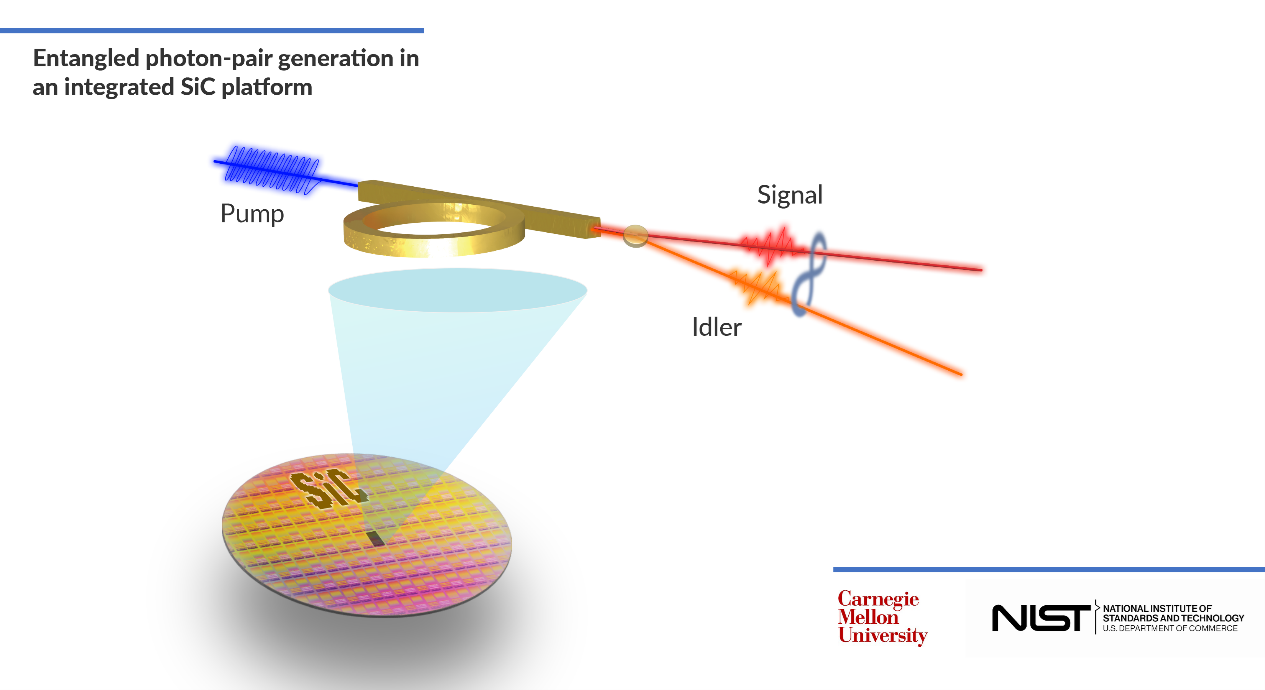Reviewed by Lexie CornerMay 21 2024
Researchers at the National Institute of Standards and Technology (NIST) in Gaithersburg, Maryland, and Carnegie Mellon University in Pittsburg, Pennsylvania, have reported the first demonstration of a chip-scale entangled photon source in silicon carbide (SiC). These findings were published in Light: Science & Applications.
 Illustration of entangled photon pair generation within an integrated SiC platform. A classical pump laser undergoes a conversion process within a microring resonator, resulting in the production of two entangled photons. This breakthrough holds great promise for enabling the scalable implementation of quantum information processing on SiC. Image Credit: Light: Science & Applications
Illustration of entangled photon pair generation within an integrated SiC platform. A classical pump laser undergoes a conversion process within a microring resonator, resulting in the production of two entangled photons. This breakthrough holds great promise for enabling the scalable implementation of quantum information processing on SiC. Image Credit: Light: Science & Applications
The study of quantum information science is highly intriguing. It explains how two minuscule particles can become entangled to the point where manipulating one will affect the other even though they are physically apart. Teleportation is a seemingly magical process that allows information to be shared between distant quantum systems. Quantum communication networks can be created by coupling these various systems via quantum processes. Distributed quantum computing, quantum sensing, and secure communications are among the many amazing potential uses.
During the thirty years of Quantum 2.0—the period of quantum research and development that involved the creation of quantum devices, systems, and protocols to produce and utilize quantum entanglement—most experiments necessitated bulky optics and specialized alignment schemes. These often involved large special-purpose optical tables that were pneumatically suspended to prevent even the smallest mechanical vibrations.
Just as miniaturized silicon-integrated electronics transformed computer processors from room-sized assemblies of capacitors, tubes, and magnets into tiny but powerful microchips with millions of components (enabling modern 'smart' technologies), quantum components and processes must be miniaturized using integrated optics. This miniaturization is crucial for transitioning quantum information science from lab-scale experiments to large-scale, real-world applications.
The use of SiC in the integrated electronic systems of green technologies, like electric vehicles, has made it a leading platform for integrated processes in recent years. This application has created significant improvements in the quality of SiC wafers, the foundational format for integrated devices. SiC has surfaced as a promising material for Integrated Quantum Photonics (IQP) in the field of quantum science, resolving scalability problems observed in other materials, such as silicon.
Due to its unique qualities, SiC is perfect for integrated quantum optical processes; however, there are still obstacles to realizing SiC’s full potential. Recent developments in the production of entangled photons on SiC microchips represent a significant advancement in the field’s quest to fully realize its potential for useful quantum applications.
The device is realized through an integrated optical microring resonator patterned onto a 4H-SiC-on-insulator platform, utilizing a high-order non-linear process called spontaneous four-wave mixing (SFWM).
The experiment is set up so that the signal and idler pairs of photons become entangled in time and energy, a phenomenon known as time-energy entanglement. These pairs of photons are at the telecom wavelength and perfect for transmission in optical fibers, which is crucial for quantum communications and quantum networking. The scientists report producing entangled photon pairs with high purity and quality.
These researchers summarize the features of the new device, stating, “Our results, including a maximum coincidence-to-accidental ratio > 600 for an on-chip photon pair rate of (9 ± 1) × 103 pairs/s and pump power of 0.17 mW, a heralded g(2) (0) on the order of 10−3, and a visibility of a two-photon interference fringe exceeding 99 % unequivocally demonstrate that integrated SiC-based devices can be viable for chip-scale quantum information processing. In addition, these results are comparable to those obtained from more mature integrated photonic platforms such as silicon.”
“We believe that our study lends strong support to the competitiveness of the 4H-SiC-on-insulator platform for quantum applications. For example, the demonstrated entangled photon source can be readily deployed in a fiber-optic network for quantum communication. In addition, by aligning the wavelength of the idler photon to the zero-phonon line of various color centers found in SiC, we can create entanglement between the signal photon and the spin state. This wavelength alignment process can also be integrated and implemented either through chip-scale dispersion engineering or frequency conversion,” added the researchers.
The future for SiC-based integrated optics is undoubtedly promising. The researchers offer, “All of these possibilities point to a bright future for SiC-based quantum photonics by enabling the integration of a multitude of chip-scale quantum photonic and electrical processes with color centers for various applications."
Journal Reference:
Rahmouni, A., et al. (2024) Entangled photon pair generation in an integrated SiC platform. Light: Science & Applications. doi.org/10.1038/s41377-024-01443-z.